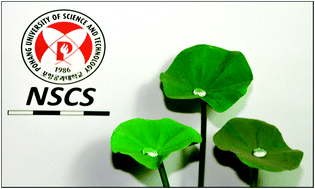Durable superhydrophilic/phobic surfaces based on green patina with corrosion resistance†
Abstract
Special wetting surfaces with superhydrophilicity or superhydrophobicity have attracted great interest because of their potential for practical applications. However, since the special wetting surface may be used in a severe environment, including polluted air and seawater, it is necessary to develop a durable special wetting surface with excellent corrosion-resistance. Here, we report a new strategy for robust superhydrophilic or superhydrophobic green patina surfaces on copper substrates with superior corrosion resistance and adhesion strength, which have great potential for treating marine pollution. The as-prepared surfaces exhibited superhydrophilicity with underwater superoleophobicity or superoleophilicity with under-oil superhydrophobicity, which allowed them to selectively separate oil and water with high efficiency. More importantly, the surface displayed not only good mechanical stability but also chemical stability in corrosive liquids owing to the intrinsic properties of the patina and hydrophobic coating. Furthermore, the surface can be utilized as coating material for the decoration of building exteriors and prevention from surface fouling. We believe that our proposed method would make it possible to develop engineering materials that require robust anti-fouling, anti-frost, and anti-corrosion properties in marine environments.


 Please wait while we load your content...
Please wait while we load your content...